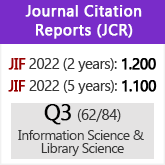New indicators of institutional scientific performance based on citation analysis: the successive H indices
DOI:
https://doi.org/10.3989/redc.2009.3.692Keywords:
H index, successive H indices, institutional assessment, citation analysisAbstract
This work discusses the proposals of Gangan Prathap and András Schubert with the aim of using the Hirsch index as a basis for the calculation of a successive series of H indices. The most recent applications of H indices in institutional assessments at micro level and for assessing institutional impact on knowledge domains are discussed. The use of successive H indices offers a holistic view of the behaviour of the research staff of institutions and its impact on the international scientific community. The use of these indices should therefore be contemplated in institutional assessment policies.
Downloads
References
1. Hirsch, J. E. (2005): An index to quantify an individual’s scientific output. Proceedings of the National Academy of Sciences of the United States of America, vol.102, pp. 16569- 16572. doi:10.1073/pnas.0507655102
2. Prathap, G. (2006): Hirsch-type indices for ranking institutions’ scientific research output. Current Science, vol. 91, p.1439.
3. Schubert, A. (2007): Successive h-indices. Scientometrics, vol. 70 (1), pp. 201-205. doi:10.1007/s11192-007-0112-x
4. Garfield, E. (2007): The history and meaning of the Journal Impact Factor. Journal of the American Medical Association, vol. 295 (1), pp. 90-93.
5. Arencibia-Jorge, R.; Barrios Almaguer, I.; Fernández Hernández, S., y Carvajal Espino, R. (2008): Applying Successive H Indices in the institutional evaluation: a case study. Journal of the American Society for information Science and Technology, vol. 59 (1), pp. 1-3. doi:10.1002/asi.20729
6. Egghe, L. (2006): An improvement of the H-index: the G-index. ISSI Newsletter, vol. 2 (1), pp. 8-9.
7. Jin, B. H. (2006): H-index: an evaluation indicator proposed by scientist. Science Focus, vol. 1 (1), pp. 8-9.
8. Rousseau, R.: New developments related to the Hirsch index. Disponible en: http://eprints.rclis.org/archive/00006376/01/Hirsch_new_developments.pdf [Consulta: 1 febrero 2007].
9. Arencibia-Jorge, R., y Rousseau, R. (2009): Influence of individual researchers’ visibility on institutional impact: an example of Prathap’s approach to successive h-indices. Scientometrics, vol. 79 (3), 507-516. doi:10.1007/s11192-007-2025-0
10. Jin, B. H.; Liang, L. M.; Rousseau, R., y Egghe, L. (2007): The R- and AR-indices: complementing the h-index. Chinese Science Bulletin, vol. 52, pp. 855-863. doi:10.1007/s11434-007-0145-9
11. Costas, R., y Bordons, M. (2007): The h-index: Advantages, limitations and its relation with other bibliometric indicators at the micro-level. Journal of Informetrics, vol. 1(3), pp. 193-203. doi:10.1016/j.joi.2007.02.001
12. Weingart, (2005): P. Impact of bibliometric upon the science system: inadvertent consequences? Scientometrics, 2005, vol. 62 (1), pp. 117-131. doi:10.1007/s11192-005-0007-7
Downloads
Published
How to Cite
Issue
Section
License
Copyright (c) 2009 Consejo Superior de Investigaciones Científicas (CSIC)

This work is licensed under a Creative Commons Attribution 4.0 International License.
© CSIC. Manuscripts published in both the printed and online versions of this Journal are the property of Consejo Superior de Investigaciones Científicas, and quoting this source is a requirement for any partial or full reproduction.All contents of this electronic edition, except where otherwise noted, are distributed under a “Creative Commons Attribution 4.0 International” (CC BY 4.0) License. You may read here the basic information and the legal text of the license. The indication of the CC BY 4.0 License must be expressly stated in this way when necessary.
Self-archiving in repositories, personal webpages or similar, of any version other than the published by the Editor, is not allowed.

















